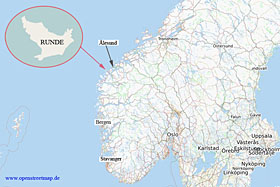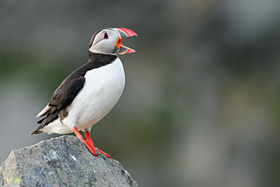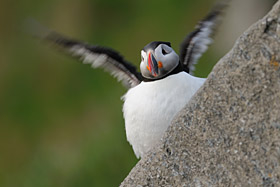Bird Island Runde
Location and arrival
Bird Island Runde is located on the west coast of Norway and belongs to the municipality of Herøy.

The island of Runde can be reached completely without a ferry from the mainland, as the 7765m long Eiksund Tunnel (the deepest road tunnel in the world) connects the mainland from the municipality of Volda to the island of Hareidlandet. After passing several bridges, one finally reaches the island of Runde from the neighboring island of Remøya via a 428m long, single-lane bridge (the Rundebrua).
For those who want to arrive by plane, Ålesund Airport is available, located on the island of Vigra near the city of Ålesund. The airport cannot be reached directly from Germany, so a stopover in Norway (e.g. Bergen, Trondheim or Oslo) is required. Rental cars can be booked at Ålesund Airport. Alternatively, there are also bus connections from the airport to Ålesund, followed by a ship and another bus connection to reach the island of Runde.
(back to the top)
Accommodation
On Runde, there are some private accommodations, a hotel, vacation homes, a youth hostel, and a campsite.
At the campsite, in addition to pitches, you can also rent various smaller wooden cabins (2-4 people).
An additional accommodation option is offered by "Kafé Runde," which is located directly at the harbor of Runde. According to the operator,
guests can book single or double rooms in addition to being served food and drinks. The guests have access to spacious common areas, a
kitchen, and two bathrooms (shower/toilet).
Now, here are my first two tips for you. Take your time on the island and stay for a few days, as there is plenty to see and discover.
Also, make sure to book your accommodation in advance, as it could be difficult to find available lodging on weekends and during peak
travel times. Personally, I would always prefer the campsite again because it provides the shortest way to get to the mountain and also
eliminates the need to search for a parking spot.
Another destination is the new environmental center (Runde Miljøsenter), which was completed in October 2009. At the time of my trip
(June 2009), the environmental center was still under construction, and now the tourist information, which was previously housed in a small
supermarket, is also available to visitors there. However, accommodations at the Runde Miljøsenter are only intended for guest researchers,
but you can certainly get further tips on accommodations at the tourist information center.
(back to the top)
The island
The island is practically only visited by bird enthusiasts. If you're not interested in the bird world, you won't discover much else on
the island. However, the bird life on Runde is exceptionally diverse. You can see almost all species of gulls, as well as a variety of puffins,
guillemots, gannets, fulmars, some sea eagles, and of course, the stars of the island, the puffins, but more on that later. Most of the birds
also breed on the island.

The climate on the island is relatively mild for Norwegian standards, but cold temperatures and unfriendly weather can be encountered throughout the year. Fortunately, we had 3 days of sunny weather, but it is still advisable to have warm and, above all, windproof clothing with you. Especially for the hike up to the rock, one should expect a very strong and cool wind.

Many more useful information about the bird island Runde can be found on the website www.insel-runde.de by Thomas Michael Müller.
(back to the top)
Atlantic puffin
As I mentioned at the beginning, the bird cliff offers a variety of different birds. However, the actual stars and also the landmark of the bird island are the puffins. There are two locations on top of the mountain where they are best seen. If you hike up the trail, you will first reach Kaldekloven (see also map), where the puffins are distributed on the small rock plates and in the small caves which they also use for breeding. If you hike about 5 minutes further southeast from Kaldekloven, you will reach the place called Lundeura. At Lundeura, there is a small, steep staircase to descend in order to get very close to the birds. From a photographic perspective, you have a higher chance of getting flight shots at Lundeura than at Kaldekloven, as you can observe the flight path longer and the birds land above you on the cliff wall.

(back to the top)
The equipment
The puffins on Runde are quite trusting and curious. I mostly sat down somewhere quietly and waited for the birds to return to the island from the Atlantic one by one in the evening. If you behave calmly, you won't need much focal length for photography. All of my puffin photos were taken with a 300mm/2.8 lens and a tripod. It would have been possible with a little less focal length, but with the 300mm lens, I had the advantage of being able to take very nice portraits with the help of teleconverters.

Some areas of the island are protected and should not be entered, especially in spring and summer. However, it is still possible to get close to the puffins for photography.
Additionally, during my photography sessions of the puffins, I was able to observe several sea eagles circling around the island. To capture sea eagles photographically, at least
a 600mm focal length would be required.
On the island, there are several water holes
(see also map)
where birds gather from time to time. Therefore, there are enough birds to discover, but I admit that during my first stay, I mostly focused on the fascinating puffins.
(back to the top)
Conclusion
As a conclusion, I would like to say that the bird island of Runde is a very worthwhile destination, especially for nature photographers, but also for all other nature lovers.
For me, it certainly won't be the last visit to the island. It's just a shame that the island is relatively difficult to reach from Germany, but since Norway is a beautiful travel
destination overall, Runde can be easily incorporated into a trip to Norway.
(back to the top)
written: Januar 2010, (author: Olaf Juergens)


